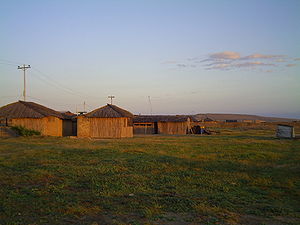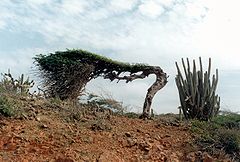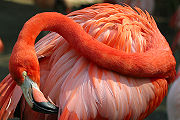
Guajira-Barranquilla xeric scrub
Encyclopedia

Deserts and xeric shrublands
Deserts and xeric shrublands is a biome characterized by, relating to, or requiring only a small amount of moisture.-Definition and occurrence:...
ecoregion
Ecoregion
An ecoregion , sometimes called a bioregion, is an ecologically and geographically defined area that is smaller than an ecozone and larger than an ecosystem. Ecoregions cover relatively large areas of land or water, and contain characteristic, geographically distinct assemblages of natural...
in Colombia
Colombia
Colombia, officially the Republic of Colombia , is a unitary constitutional republic comprising thirty-two departments. The country is located in northwestern South America, bordered to the east by Venezuela and Brazil; to the south by Ecuador and Peru; to the north by the Caribbean Sea; to the...
, covering an estimated area of 150.000 km2.
Setting

Guajira Peninsula
Guajira Peninsula , is a peninsula in northern Colombia and northwestern Venezuela in the Caribbean Sea...
, the valley of Rancheria river
Ranchería River
The Ranchería River is a river located in northern La Guajira Department, Colombia. Born in the Sierra Nevada de Santa Marta southern steps flows south, abruptly turns northeast and then north towards the Caribbean sea where it finally flows into.-2007 Floods:...
and Guajira Department, covering parts of the northeastern coast of Venezuela
Venezuela
Venezuela , officially called the Bolivarian Republic of Venezuela , is a tropical country on the northern coast of South America. It borders Colombia to the west, Guyana to the east, and Brazil to the south...
. The valleys lie in the rain shadow
Rain shadow
A rain shadow is a dry area on the lee side of a mountainous area. The mountains block the passage of rain-producing weather systems, casting a "shadow" of dryness behind them. As shown by the diagram to the right, the warm moist air is "pulled" by the prevailing winds over a mountain...
of the surrounding mountain range of Macuira
Serranía de Macuira
Serranía de Macuira is a mountain range in northern Colombia located in the municipality of Uribia, Guajira Peninsula and part of the La Guajira Department. The Serrania de Macuira stands in the middle of the La Guajira Desert at 864 meters over sea level, isolated from the mountain ranges of...
that reaches 900 m over sea level that trap some of the Trade winds and cause mist
Mist
Mist is a phenomenon of small droplets suspended in air. It can occur as part of natural weather or volcanic activity, and is common in cold air above warmer water, in exhaled air in the cold, and in a steam room of a sauna. It can also be created artificially with aerosol canisters if the...
. An important touristic destination in the area is Cabo de la Vela
Cabo de la Vela
Cabo de la Vela is a headland in the Guajira Peninsula in Colombia with an adjacent small fishing village. It is a popular ecotourism destination of the Caribbean Region of Colombia-History:...
Flora

Protected area
Protected areas are locations which receive protection because of their recognised natural, ecological and/or cultural values. There are several kinds of protected areas, which vary by level of protection depending on the enabling laws of each country or the regulations of the international...
called National Natural Park of Macuira. Nearby there is also the 80 km² Flamingos Fauna and Flora Sanctuary
Flamingos Fauna and Flora Sanctuary
Flamingos Fauna and Flora Sanctuary has been a natural park since 1977. It is located in the Colombian Caribbean Region and the Guajira Peninsula and part of the department of La Guajira....
, which is a center of plant diversity, with over 2700 species, of which approximately 30% are endemic
Endemic (ecology)
Endemism is the ecological state of being unique to a defined geographic location, such as an island, nation or other defined zone, or habitat type; organisms that are indigenous to a place are not endemic to it if they are also found elsewhere. For example, all species of lemur are endemic to the...
. It is a center of diversity for species of Divi-divi
Divi-divi
Caesalpinia coriaria is a leguminous tree or large shrub native to the Caribbean, Mexico, Central America, and northern South America. Common names include Divi-divi, Cascalote, Guaracabuya, Guatapana, Nacascol, and Watapana .- Description :C...
, Hechtia
Hechtia
Hechtia is a genus of the botanical family Bromeliaceae, subfamily Pitcairnioideae. The genus is named for Julius Gottfried Conrad Hecht , German counselor to the King of Prussia.. Except for H. gayorum, the plants of this genus are dioecious.-Species:-External links:* photos...
, Salvia
Salvia
Salvia is the largest genus of plants in the mint family, Lamiaceae, with approximately 700-900 species of shrubs, herbaceous perennials, and annuals. It is one of several genera commonly referred to as sage. When used without modifiers, sage generally refers to Salvia officinalis ; however, it is...
, and cactus
Cactus
A cactus is a member of the plant family Cactaceae. Their distinctive appearance is a result of adaptations to conserve water in dry and/or hot environments. In most species, the stem has evolved to become photosynthetic and succulent, while the leaves have evolved into spines...
.
Fauna

Caribbean Flamingo
The American Flamingo is a large species of flamingo closely related to the Greater Flamingo and Chilean Flamingo. It was formerly considered conspecific with the Greater Flamingo, but that treatment is now widely viewed as incorrect due to a lack of evidence...
(Phoenicopterus ruber), besides a diversity of birds and bats.

